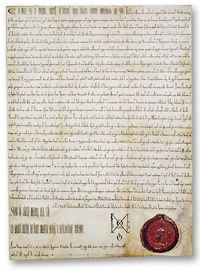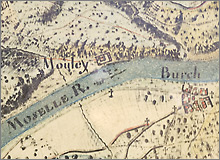 Cochem anno 1143
Cochem anno 1143
A mysterious name has drifted to us from a distant past: »Molun«.
It can be found in a certificate from the year 1143. During this time, King Konrad III confirmed at an assembly in Cochem of the Augustiner Abbey Springiersbach in the Eifel, that the late Pfalzgraf (count) Wilhelm von Ballenstedt, had donated a number of properties between Cochem and Wittlich, Daun and Mayern, just prior to his death.
As translated in the certificate, among these properties there was also an access yard between »Borga« (Burg) and »Rila« (Reil): »In solitudine super mosellam in loco qui dicitur Molun, agros, vineas cum exitibus et ingressibus suis.« (»In the loneliness above the Mosel in the place called Molun, lay fields and vineyards containing exits and entrances«
 »Molun« means the Springiersbach’ property positioned at the tow path between Reil and Koevenig in a hollow surrounded by rocks. It would then be referred to as »Moley« and »Mulay«, among other names. Maybe it was the wild and romantic idyll that led to the description of it’s location: »Loneliness at the Mosel«. The primary word, »Lay« (»Ley«) which is contained in the name of the property, is an indication that the landscape is dominated by slate. The property itself stood in close proximity to a high cliff at the entrance to a side valley (the southern end of today’s Mullay Hofberg).
»Molun« means the Springiersbach’ property positioned at the tow path between Reil and Koevenig in a hollow surrounded by rocks. It would then be referred to as »Moley« and »Mulay«, among other names. Maybe it was the wild and romantic idyll that led to the description of it’s location: »Loneliness at the Mosel«. The primary word, »Lay« (»Ley«) which is contained in the name of the property, is an indication that the landscape is dominated by slate. The property itself stood in close proximity to a high cliff at the entrance to a side valley (the southern end of today’s Mullay Hofberg).
Over time, Mulay became the Abbey’s most important winery. It was here, not far from Springiersbach, that the abbots created a secondary residence which was occasionally used as a retreat. It’s history mirrors the vicissitudes of times in many ways.
As a consequence of secularization in 1802 the property was to be auctioned but eventually demolished. Present landmark names and remaining wall ruins provide the only evidence of it’s existence.
Well, not the only form of evidence – Mulay is still quite literally alive! We at Weingut Melsheimer produce a Riesling here as a hommage to the age-old viticultural tradition in these slopes; one which proudly carries this historical name. »Liquid history« so to speak ...